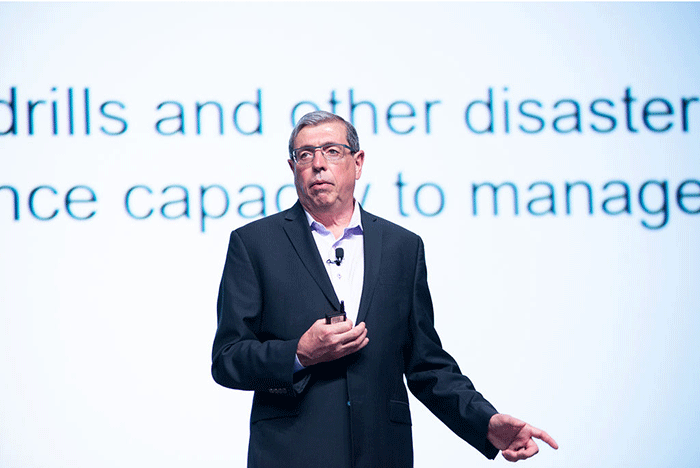Summit zeroes in on designing for safety and satisfaction

Image courtesy of ASHE
Read our recaps of Days 1 and 3 of the PDC Summit.
Building a culture of safety was the focus during this morning’s general session at the International Summit & Exhibition on Health Facility Planning, Design & Construction (PDC Summit) in Phoenix.
In a session titled “Compliance with Accreditation – Leading the Way to Zero,” Mark G. Pelletier, R.N., MS, COO of accreditation and certification operations for The Joint Commission, covered key accreditation requirements laid out by his organization and ways hospital can ensure compliance.
Pelletier challenged the room of health care facility professionals to “imagine a new now” to build on improvements in patient and staff safety. To get there, he says, hospitals must continue in their journeys to becoming high-reliability organizations (HRO).
The first step to becoming an HRO is to have leadership that is committed to quality first. Pelletier explains that there can be many factors vying for primary attention among hospital leadership, including managing financials and strategic initiatives. However, even though “financials are important,” he says, “if you get the quality aspect down, the financials will come.”
Next, he advises hospitals to scrutinize their work culture and develop an organization that encourages staff to admit when they’ve made a mistake and also to report instances in which colleagues do not adhere to best practices. Pelletier listed several markers of culture of safety, including addressing intimidating peer-to-peer behavior and separating blameless errors from blameworthy errors.
By addressing workforce issues, Pelletier says that health care organizations will start to make progress in more than just compliance.
He also touched on guidance developed by the Joint Commission to discuss physical environment issues, such as ligature risk.
Watch the video below to learn more about The Joint Commission’s Leading the Way to Zero initiative.
Zero Patient Harm IS Achievable from The Joint Commission on Vimeo.
In yesterday afternoon's general session, PDC Summit attendees listened in on a panel discussion titled “Alignment of Priorities in Health Care Design.”
The panel was facilitated by Vincent Della Donna, AIA, ACHA, a health care consultant and 2019 immediate past president of the AIA Academy of Architecture for Health. He was joined by five panelists: Peter Bardwell, FAIA, FACHA, principal, Bardwell+associates; Chad Beebe, AIA, CHFM, CFPS, CBO, FASHE, deputy executive director, advocacy, ASHE; Bradley Taylor, MBA, CHFM, CHC, system vice president, construction and project management, Fairview Health Services, and ASHE's immediate past president; Ellen Taylor, Ph.D., AIA, MBA, EDAC, vice president for research, Center for Health Design; and Lisa Walt, Ph.D., senior research analyst, ASHE.
During the session, the panel analyzed results of four polls that compared the perspectives of health care designers, administrators, contractors, consultants and others on health care design priorities and how population health and value-based care will affect future hospital campuses.
The panelists first looked at the personal factors driving patients’ health care decisions and then assessed poll results to see if those patient needs were reflected in health care planning and design decisions. Expertise and experience, as well as convenience were the top factors influencing patient decisions on where to seek care.
The convenience factor was reflected in the poll with 92 percent of respondents agreeing that health care is being decentralized. Population health also came into play as 62 percent of respondents say that community health programs should be a high priority to focus government resources.
The polls also looked into health care design and construction practices. Seventy-four percent of respondents said they are very likely to invest in security system upgrades, while 89 percent said resilient design is also a top priority. Offsite fabrication of standardized components ranked high, with 97 percent of respondents saying they see the value of it. The panelists agreed that they would like to see the use of mock-ups to aid in the design process increase, as 75 percent of respondents say that they have used the design tool before.
In all, Taylor says the polls reflected the growing awareness of the power of good design and planning.
“Health care executives are starting to understand differently that design could have an influence on health care outcomes,” she says.

